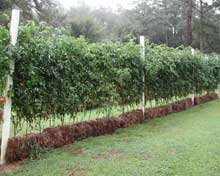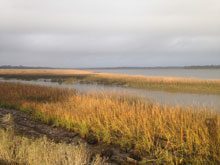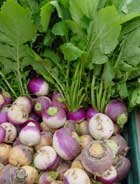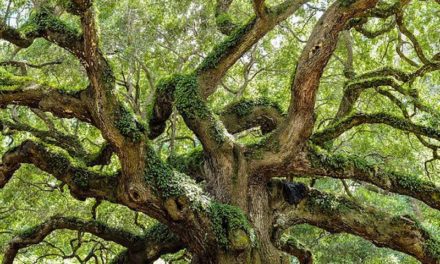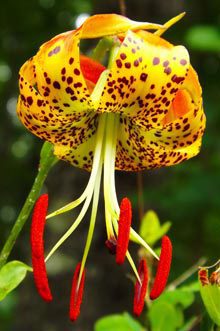 Who would have thought that we nice, quiet gardening folks would get worked up to such a furious tizzy about terribly esoteric subjects like “natives” vs “exotics?” Why, we even fight over the definitions! But get us started on whether we are threatening the earth when Lowcountry gardeners plant Lilium auratum instead of Lilium superbum (left), and you’d better be ready to choose sides.
Who would have thought that we nice, quiet gardening folks would get worked up to such a furious tizzy about terribly esoteric subjects like “natives” vs “exotics?” Why, we even fight over the definitions! But get us started on whether we are threatening the earth when Lowcountry gardeners plant Lilium auratum instead of Lilium superbum (left), and you’d better be ready to choose sides.
Well, right now I’m not going to choose sides in that debate – partly because the sides keep moving; it is, though, a topic well worth exploring in these pages. Perhaps in a future essay, I can pull together some of the various positions and discuss them. As esoteric as the issues seem, they all attempt to find responsible ways to maintain a healthy and productive environment, and to avoid unintended consequences which in the past have sometimes proven disastrous.
One thing I do feel like writing about here, however, is finding and using native plants – or wildflowers – or weeds – in the garden. The great plant explorers of the Eighteenth and Nineteenth Centuries found spectacular plants growing wild here in the coastal plain of the Carolinas and Georgia. Many of these plants were collected, studied, identified, and then promoted to gardeners in Europe. Then, no longer wildflowers and weeds, they were reimported to America as fashionable garden plants.
Many of these returning glories are well known. One of the grandest and most 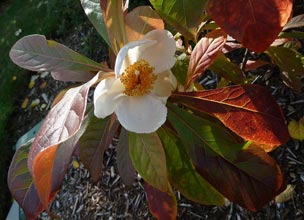 admired trees all over the world is the Southern Magnolia, Magnolia grandifolia. The lovely native windflower, Anemone caroliniana, and the Carolina phlox, Phlox caroliniana, both reveal their American origins in their Latin names. The famous and beautiful Franklinia tree, Franklinia alatamaha (right), was found near Savannah by the Bartrams in 1765. Samples were collected and distributed among arboretums around the world, which is fortunate indeed. Since it was initially sighted in the wild 250 years ago, it has never been found again growing in its native habitat. The only examples of its existence are descendants of the pieces collected by the Bartrams in Georgia.
admired trees all over the world is the Southern Magnolia, Magnolia grandifolia. The lovely native windflower, Anemone caroliniana, and the Carolina phlox, Phlox caroliniana, both reveal their American origins in their Latin names. The famous and beautiful Franklinia tree, Franklinia alatamaha (right), was found near Savannah by the Bartrams in 1765. Samples were collected and distributed among arboretums around the world, which is fortunate indeed. Since it was initially sighted in the wild 250 years ago, it has never been found again growing in its native habitat. The only examples of its existence are descendants of the pieces collected by the Bartrams in Georgia.
There are a number of native plants growing all around us, plants which can be fully as magnificent as garden plants as they are successful in the wild. In most cases, these natives choose particular sites and specific conditions in which to flourish; the wise gardener would do well to pay particularly close attention to the conditions such a plant chooses; success in using it in the garden may depend on providing conditions somewhat similar to those conditions in the wild.
Such things to notice would certainly include water (Is it in a ditch filled with water? On a sandy ridge?), light (Does it get glaring sun all day? Morning sun? Is it in the shade?), soil (Is it in rich leaf-litter? Perhaps sprouting from a pile of old bricks and mortar? Sand?).
Bear in mind as well that the conditions to which wild plants are adapted are often not rich in nutrients. Putting those plants in a highly fertilized, frequently-watered garden could create a monster – or could kill the plant. Gardening with native plants can have at least as many challenges as gardening with plants from Kmart. But the rewards just may outstrip the rewards from those big-box-store plants.
Among the most significant rewards to be gotten from native plants is that the “inputs” – fertilizer, water, etc – may be reduced to almost nothing. And everyone already knows that the wildlife – birds, butterflies, helpful insects like bees – is adapted to the native flora. Sometimes, even exclusively to a particular plant. So planting the native flora helps assure the survival of native fauna. This is important because very often imported plants, while beautiful, may provide no sustenance at all to the insects and animals of an area. If we plant only those imports, we reduce the availability of food and shelter sources for those creatures, contributing to their decline.
There are some wonderful native plants in the Lowcountry that I find so stunningly beautiful I think they deserve a place in the garden – assuming, of course, that the garden provides the right conditions for the plant. I’ve written before in these pages about one of the dozens of types of goldenrod that I’ve become completely smitten with, Solidago stricta, of which I have only recently found the correct name. The Wand Goldenrod sends up an absolutely straight stalk, the top third of which is covered in the typical golden flowers. It is an exclamation point in the landscape, a vertical line. A mass of them is spectacular.
One of the most impressively colored native plants is coming into bloom now, and dramatic stands of its intense, brilliant dark purple flower heads atop 6 to 10 foot tall plants align many roadside ditches. There are a number of species of Vernonia, or Ironweed, but this very tall variety is V. gigantea or perhaps V. altissima. Obviously, it would take a garden of a certain scale to handle such a large plant, but the Ironwood and the Wand Goldenrod blooming together would be breathtaking.
There are other natives which aren’t quite as “spectacular”; rather, they are downright diminutive. But the Grassleaf Roseling (Callisia graminea) is a tiny wonder, looking like a very small clump of grass for most of the year, but blooming in the early summer with exquisite tiny pink flowers looking just like a miniature Wandering Jew. It prefers the sandy hills of the midlands but ranges broader in suitable sites. In the right setting, where the visitor to the garden can get up close to appreciate such a small treasure, the native Roseling is a jewel to treasure.
Now, I must caution those dear readers who may be moved to go right outside and dig up a few wildflowers to put in the garden. It is ill-advised. In addition to the risk of trespassing and the irreparable damage to native habitat, the fact is that most wild-dug plants rarely survive the attempt at transplanting.
Instead, locate a responsible nurseryman who specializes in native plants, like Danny Paine at Naturescapes Beaufort. In addition to getting healthy, ready-to-plant examples, you will have access to tremendously knowledgeable experts anxious to share the best information and advice. You will be advised on whether a particular plant will likely do well for you, or you may be pointed toward a more likely candidate for your garden.
Plus, you will get the enormous satisfaction of maintaining the traditions of the great plant hunters, like Catesby and the Bartrams.

